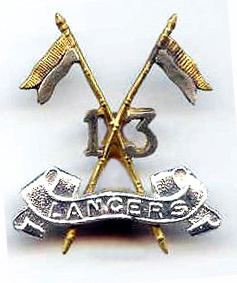Active 1804 - Present Type Armoured Regiment | Branch Army Nickname(s) The Spearhead Regiment | |
 | ||
Allegiance British Crown 1804 - 1947 Pakistan 1947 - Present | ||
The 13th Lancers is an armoured regiment of Pakistan Army. It was formed in 1923 as 13th Duke of Connaught's Own Lancers by the amalgamation of 31st Duke of Connaught's Own Lancers and 32nd Lancers. On Partition of India in 1947, the regiment was allotted to Pakistan.
Contents
Formation
The two parent regiments of 13th Lancers had a common origin in the old Bombay Squadron of Cavalry, raised for service in the Second Anglo-Maratha War. The squadron was split to form the 1st and 2nd Regiments of Bombay Light Cavalry in 1817. More than a hundred years later, they were reunited to form the 13th Duke of Connaught's Own Bombay Lancers in 1923.
31st Duke of Connaught's Own Lancers
The 1st Bombay Light Cavalry served in the First Afghan War in 1839 when they fought in the Battle of Ghazni and took part in the march to Kabul. During the Second Sikh War of 1848-49 the regiment took part in the Siege of Multan, where they remained as the garrison for the remainder of the campaign. At the start of the Great Mutiny of 1857, the regiment was stationed at Nasirabad, where they were the only ones to remain loyal. Artillery and infantrymen urged them to go over to them but the sowars refused and, under their officers, charged in an attempt to take the guns. They failed to do so but successfully disengaged and took part in the campaign of pacification in Central India. Burma was their next overseas posting in 1885, where they fought in the Third Anglo-Burmese War. The Duke of Connaught, then Commander-in-Chief of the Bombay Army, became their Colonel-in-Chief in 1890. He still held the appointment in the 13th DCO Lancers on his death in January 1942. During the Kitchener reorganisation of the Indian Army of 1903, the Bombay cavalry had thirty added to their numbers and, the 1st (Duke of Connaught's Own) Bombay Lancers became the 31st Duke of Connaught's Own Lancers. During the Great War, the 31st Duke of Connaught's Own Lancers remained on the North West Frontier of India. In 1919, they served in the Third Afghan War and then went to perform garrison duties in Palestine.
32nd Lancers
The 2nd Bombay Light Cavalry were stationed at Neemuch in 1857 and took part in the pacification of Central India. One of its officers, Captain James Blair, won the Victoria Cross during these operations. Under Kitchener's Reforms, the 2nd Bombay Lancers was redesignated as the 32nd Lancers.
During the Great War, the 32nd went to Mesopotamia late in 1916 and were the first British troops to enter Baghdad. In April 1917, at the Battle of Istabulat, a detachment led by the commanding officer, charged an entrenched Turkish position resulting in all the officers and most of the men becoming casualties.
13th Duke of Connaught's Own Lancers
After the First World War, the number of Indian cavalry regiments was reduced from thirty-nine to twenty-one. However, instead of disbanding the surplus units, it was decided to amalgamate them in pairs. This resulted in renumbering and renaming of the entire cavalry line. In September 1923, the 31st Duke of Connaught's Own Lancers were amalgamated with the 32nd Lancers to form 13th Duke of Connaught’s Own Bombay Lancers. This particular merger, of course, was simply a reunion of two regiments separated more than a hundred years before. The new badge was to be crossed lances with '13' on the intersection; a crown above and a scroll below, reading 'Duke of Connaught's Own.' Their uniform was blue with scarlet facings, and the new class composition was one squadron each of Pathans, Muslim Rajputs and Sikhs. In 1927, the regiment was redesignated as the 13th Duke of Connaught's Own Lancers.
The 13th Duke of Connaught's Own Lancers were one of the first two Indian cavalry regiments nominated for mechanisation. One squadron was equipped with the Vickers Medium Mark I tank and two squadrons with armoured cars. They were deployed on frontier duties but in April 1941, left for Iraq with the 10th Indian Division. They saw action against the Vichy French in Syria and also served in Persia and Iraq before joining the British Eighth Army in North Africa. In October 1942, they moved back to Persia and then to India. After the Japanese surrender in 1945, the regiment moved to Java in the Dutch East Indies in support of the 5th and 23rd Indian Divisions, who were engaged in suppressing a revolt by the Indonesians. In August 1946 the regiment returned to Secunderabad and on Partition of India in August 1947, the 13th Duke of Connaught's Own Lancers were allotted to the Pakistan Army.
In 1956, Pakistan became a Republic and all titles pertaining to the British royalty were dropped. The regiment was now designated as 13th Lancer. During the Indo-Pakistani War of 1965, the regiment spearheaded the advance of Pakistan Army towards Akhnoor in Kashmir. Fighting with great elan, it penetrated 23 miles inside enemy territory. During the Indo-Pakistani War of 1971, 13th Lancers launched a gallant counter-attack against invading Indian forces at Barapind near Zafarwal and suffered heavy casualties. Between 1996 and 1997, the regiment served as part of the UN peacekeeping force of UNTAES in former Yugoslavia.
Battle honours
Ghuznee 1839, Afghanistan 1839, Mooltan, Punjaub, Central India, Afghanistan 1879-80, Burma 1885-87, Kut al Amara 1917, Baghdad, Sharqat, Mesopotamia 1916-18, NW Frontier, India 1917, Afghanistan 1919, Damascus, Deir ez Zor, Raqaa, Syria 1941, Gazala, Bir Hacheim, El Adem, Sidi Rezegh 1942, Gambut, Tobruk 1942, Fuka, North Africa 1940-43, Dewa-Chamb 1965, Jaurian 1965, Zafarwal 1971.
